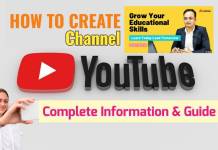How to write a resume for job interview – Resume writing skills
How to write a resume for job: People write resumes for various reasons. The most common is applying for new jobs. However, resumes are often used to solicit promotions within an organization or to provide the employer with important information when a position is reclassified. Whatever your motive for writing a resume, its basic purpose is the same to communicate your experience, skills, and education related to an exact position to an employer. In short, CVs are a marketing tool. Think of your resume as a promotional brochure designed to get you an interview.
Your resume is not the place to report an autobiography or every experience you’ve ever experienced. It’s a place to report the qualifications you have that relate to a specific position. Writing an effective and specific resume is time-consuming, however, it is not as difficult as many people think. The most important/significant thing to remember is that there is no one right way to do it. Your resume will be the same as you are.
After reading this brochure and attending the resume workshop at Student Employment Services, if you think you need additional help with your resume, please prepare a working copy and schedule an appointment for one of our employment coordinators to review it.
Resume Writing Skills
The first step in writing a resume is identifying all of your skills, attributes, and experiences. This is not always easy to do, as people tend to be modest and overlook their own abilities. In this case, however, it is important to “sound your own horn” and not underestimate yourself.
One method to start (How to write a resume for job) is to write down everything you have done. You can create titles like volunteer work, paid work, education, awards, memberships, extracurricular activities, and special skills, and then list all of your experiences under the appropriate heading. This is the best way to make sure you don’t forget anything.
Another reason to start by listing your experience is that it will help you identify your skills. Once your list of experiences is complete, look at each item on your list and ask yourself, “What could you have learned by doing this?” “What skills did I develop?”
Step 1: Choose Between 3 Formats – For How to write a resume for job
To get started, try organizing all your information with a resume summary. This helps you see where your strengths and weaknesses lie, and what aspects of your career history you should emphasize. Then decide which resume format is suitable for your application.
Your formatting decision comes down to 3 options: reverse chronological, functional, and combined. Every format has its own advantages and disadvantages, and each positions the sections of a resume in a unique way.
It is mentioned below that you will find which one is best for you.
Format 1: Reverse Chronological
This is the most traditional format and what you are most likely to encounter in the real world (as an applicant or hiring manager). Chronological resume (CV) formats are generally more flexible/supple and can be used by applicants with any level of experience.
Format 2: Functional
While the timeline puts an emphasis on career progression, a functional resume is for a skills-based resume. Since it places a lot of emphasis on the applicant’s qualifications, the functional format is best suited for those with an expert level of experience.
The functional format has many of the same resume sections as the chronological one, but with a few key differences.
Format 3: Combination
As you can probably guess, the combined resume format combines snippets of chronological and functional formats. Comparable to the functional format, it focuses on exact qualifications, but the body of the document contains professional experience comparable to the chronological format. This format is generally reserved for those who have a lot of experience in a particular industry.
Step 2: set up your contact information
Before paying attention to the information you need to add, it is important to remember that the information you include will largely depend on the format you choose. With that said, here is a general guide on what information to add and the order in which it should be added.
- Name
- Mailing Address
- Phone number
- Email address
- Link to online portfolio (optional, make sure it’s relevant to the position)
- LinkedIn profile
Step 3: write a winning introduction
All resume submissions are written with the same goal in mind to get the attention of a potential employer by highlighting relevant skills and experience.
Read Also: Top 10 HR Interview Questions and Answers – How to write a CV template
Resume Intro 1: Qualification Summary
In terms of format, the grade summary is a bullet point list (ranging from 4 to 6 points) of your most outstanding professional achievements. Avoid using generic declarations and try to list your skills in a way that reproduces your exclusive voice.
Intro Summary 2: Resume objective
A resume goal (or career goal) is a 2-3 sentence statement that provides an overview of your skills and experience. This introduction is best for entry-level candidates.
Resume Intro 3: Professional Profile
The career profile is a combination of both the career objective and the qualifications summary. It is also the most flexible/ supple of the four styles, as it can be formatted as a short paragraph or a bullet list.
Resume Intro 4: Resume Summary
Resume summaries (sometimes referred to as “professional summaries”) include four to five bulleted sentences that highlight your past accomplishments through the use of quantifiable data. To make this data stand out, each sentence includes a bold caption to guide hiring managers to their most commercial traits.
Step 4: highlight your relevant work experience
This section is one of the most essential parts of a resume and is where you are tasked with demonstrating the skills that you have listed in your qualifications summary or career objective. When it comes to tagging this section, some use “Relevant Experience” or “Work Experience” as an alternative to “Professional Experience.”
Remember to list your work experiences in reverse chronological order and only list the experience that is relevant to the job you are applying for. For each company, create a heading that includes the name, city, and state of the company, your title, and dates of employment (month and year). Option to guide hiring managers to their most commercial characteristics.
Step 5: create a career education section
Having a solid education section helps show the foundation/basis of your knowledge and experience. Depending on your professional experience, you may want to consider changing the order of the education and professional experience sections.
For example, college or high school students who lack experienced professional experience benefit from emphasizing their education by placing it before the professional experience section.
Step 6: use a variety of hard and soft skills on your resume
Hiring managers are looking for skilled people. Listing a bunch of skills on your resume doesn’t really make you look slick, spreading your various skills on your resume will get the attention of your application reviewer.
Read Also: Best Career Advice for Jobseekers – Best Career Tips
Including various skills in the introduction to your resume and even in the work experience section will help strengthen your candidacy. And of course, there is a skills section that you can really dive into depending on your field. But first.
Step 7: Link key certifications, awards, and Honours
By now you have added the nuts and bolts to your resume. Here are some sections you can consider adding to help make it stronger.
Certifications / Licenses
The certifications section is the most important of the other sections you can include, but adding certifications or licensing section is highly dependent on your industry. For example, the attention field has strict licensing requirements, while the customer service sector does not.
Step 8: Stylize your resume
So the hard part is over. You have all your content written and you feel confident in getting that interview. Now the final touches. It’s time to design your resume. But first, let’s tackle one of the most controversial elements of writing a resume.
Step 9: Write a Matching Cover Letter
Your cover letter gives you the opportunity to connect with a hiring manager on a level deeper than your resume, and together these two crucial documents work together to provide you with a satisfying job. But be sure to check out our full list of cover letter tips when writing yours to make sure you’re getting all the points right.
Step 10: correct your resume and finish well
Read it multiple times at different times of the day to make sure everything looks good. Something that sounded good the night before might not look so good in the morning once the sun is up and you’re better rested.
General advice for Resume Writing skills
- Your resumes should be 1-2 pages long. If your resume (CV) is longer than this, you should consider another format. This is important as employers require brief information that is easy to access and often does not read beyond the second page.
- Your resume must be printed on good-quality paper and printers. White or shaded paper is accepted. Originals are the best, but if copies are used, they must be of good quality, you may want to use a professional copier.
- It is very important that your resume is free of errors. Read it several times and have your friends or relatives review it too. A fault on your resume is a sure way to exclude yourself.
- Your resume should be good and well-organized and presented in a logical manner. You should include enough margins and whitespace as this makes your resume easier to read and visually view.
- Dates can be placed on the right, left, or in the middle of your page. Whatever you want, it is important that you stay consistent throughout your resume.
So, Friends, I hope you like these articles which were related to “How to write a resume for job – Resume writing skills. if you like it, don’t forget to comments on us. Thank you








































